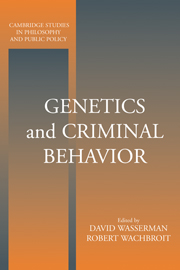Book contents
- Frontmatter
- Contents
- List of Contributors
- Acknowledgments
- 1 Introduction: Methods, Meanings, and Morals
- PART I
- 2 Understanding the Genetics-of-Violence Controversy
- 3 Separating Nature and Nurture
- 4 Genetic Explanations of Behavior: Of Worms, Flies, and Men
- 5 On the Explanatory Limits of Behavioral Genetics
- 6 Degeneracy, Criminal Behavior, and Looping
- 7 Genetic Plans, Genetic Differences, and Violence: Some Chief Possibilities
- PART II
- Index
7 - Genetic Plans, Genetic Differences, and Violence: Some Chief Possibilities
Published online by Cambridge University Press: 05 June 2012
- Frontmatter
- Contents
- List of Contributors
- Acknowledgments
- 1 Introduction: Methods, Meanings, and Morals
- PART I
- 2 Understanding the Genetics-of-Violence Controversy
- 3 Separating Nature and Nurture
- 4 Genetic Explanations of Behavior: Of Worms, Flies, and Men
- 5 On the Explanatory Limits of Behavioral Genetics
- 6 Degeneracy, Criminal Behavior, and Looping
- 7 Genetic Plans, Genetic Differences, and Violence: Some Chief Possibilities
- PART II
- Index
Summary
“Heritability” is not inheritance. The distinction between the two is one of the first things to learn for anyone who encounters the discipline of genetics. A normal human being inherits two-leggedness, the crucial characteristic of having two legs. This characteristic, though, might have low heritability in the human population.
“Heritability” is a technical term used by geneticists. Heritability is a property not of an individual but of a population: a single characteristic of an individual might have high heritability in one population the individual is in and low heritability in another. Heritability concerns differences: it is a matter of the degree to which, in a given population, differences in a characteristic trace back to differences in individuals' genotypes. Let an entire population be two-legged, and the heritability of two-leggedness in that population is simply undefined in that population; there are no differences in two-leggedness to be accounted for. In another human population, suppose, everyone is born with two legs, but occasionally someone loses a leg in an accident. If the accidents have no correlation with genotype, then in that population the heritability of two- leggedness is zero. In another population, imagine, blue-eyed children are fed to lions, but some of them survive, maimed. If eye color is inherited and this grim ritual is the predominant cause of anyone's lacking a leg in that population, then non-two-leggedness, in that population, has substantial heritability.
- Type
- Chapter
- Information
- Genetics and Criminal Behavior , pp. 169 - 198Publisher: Cambridge University PressPrint publication year: 2001
- 4
- Cited by



